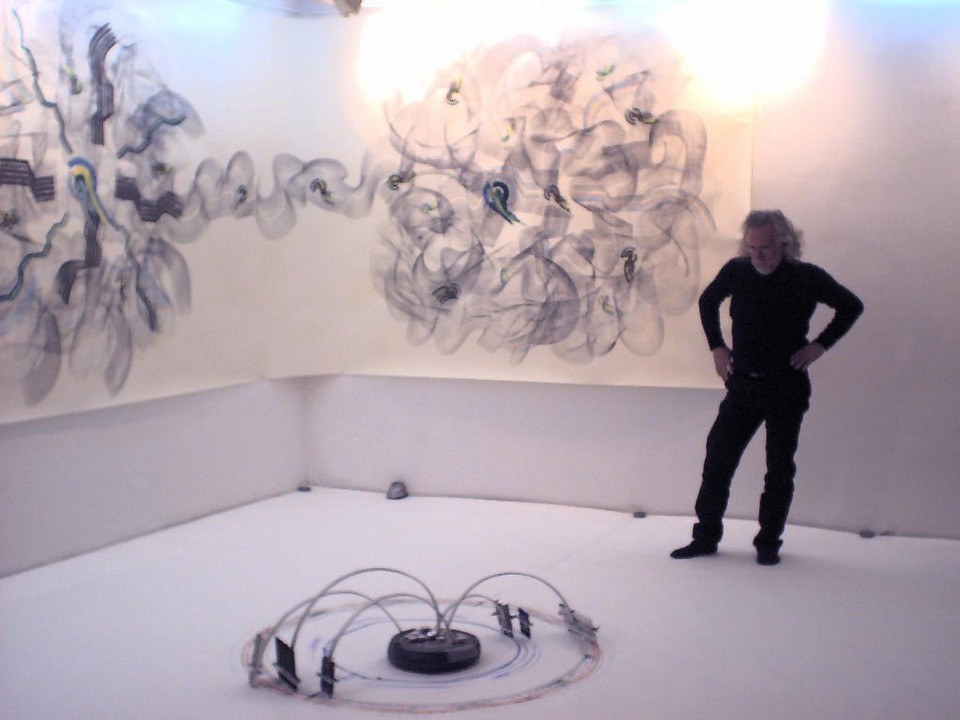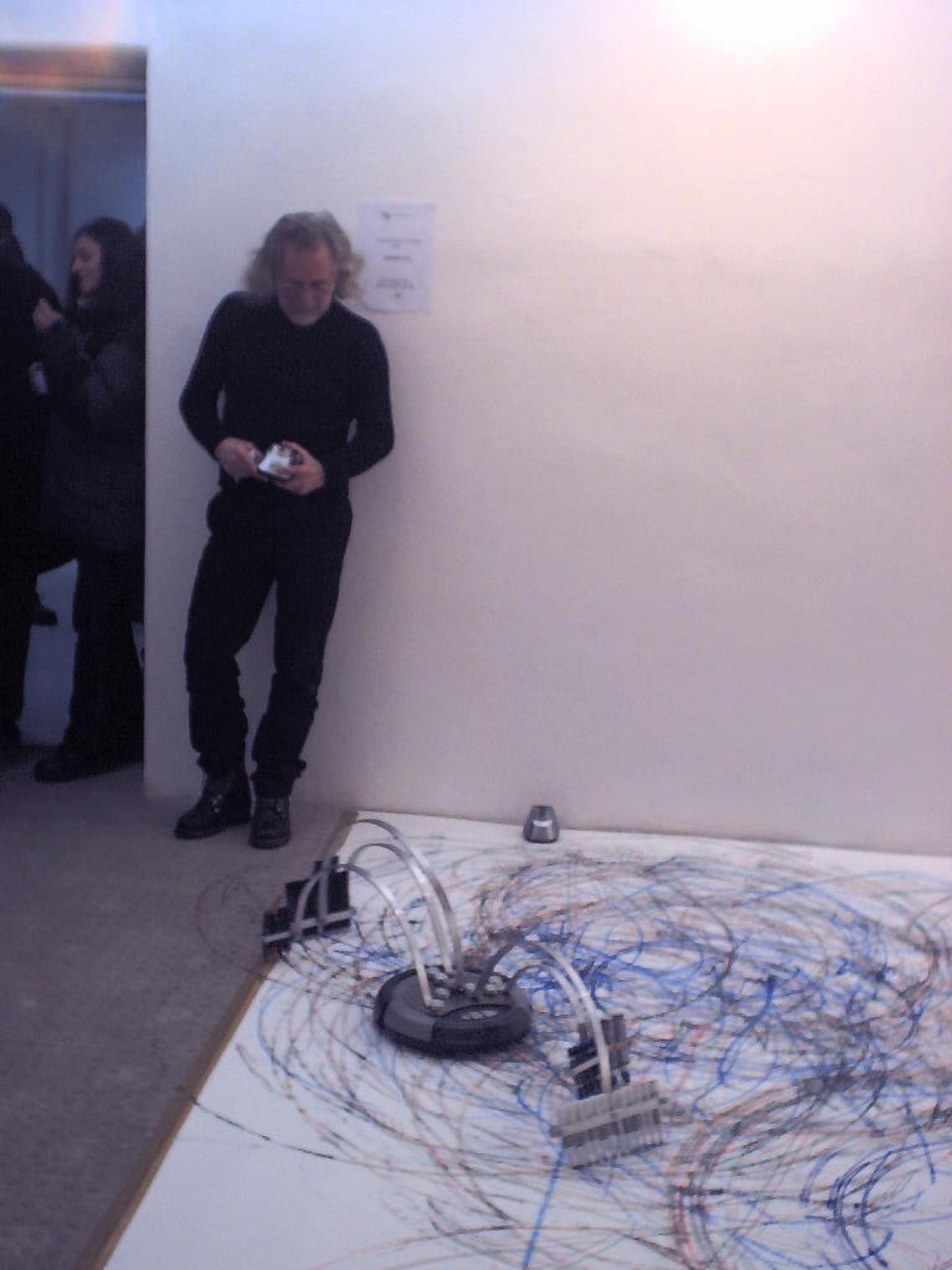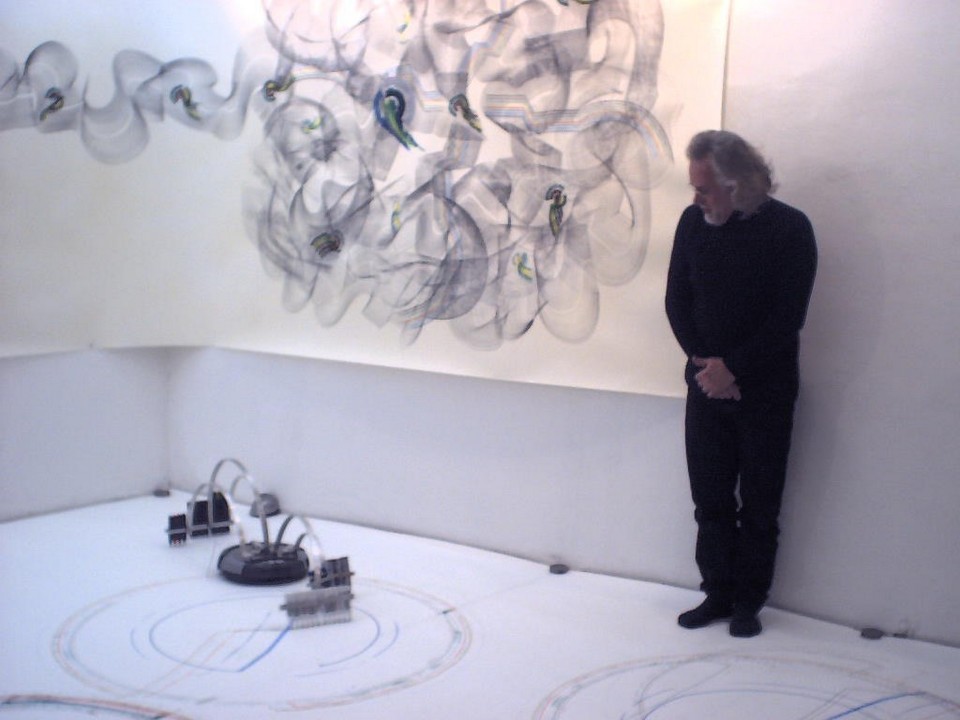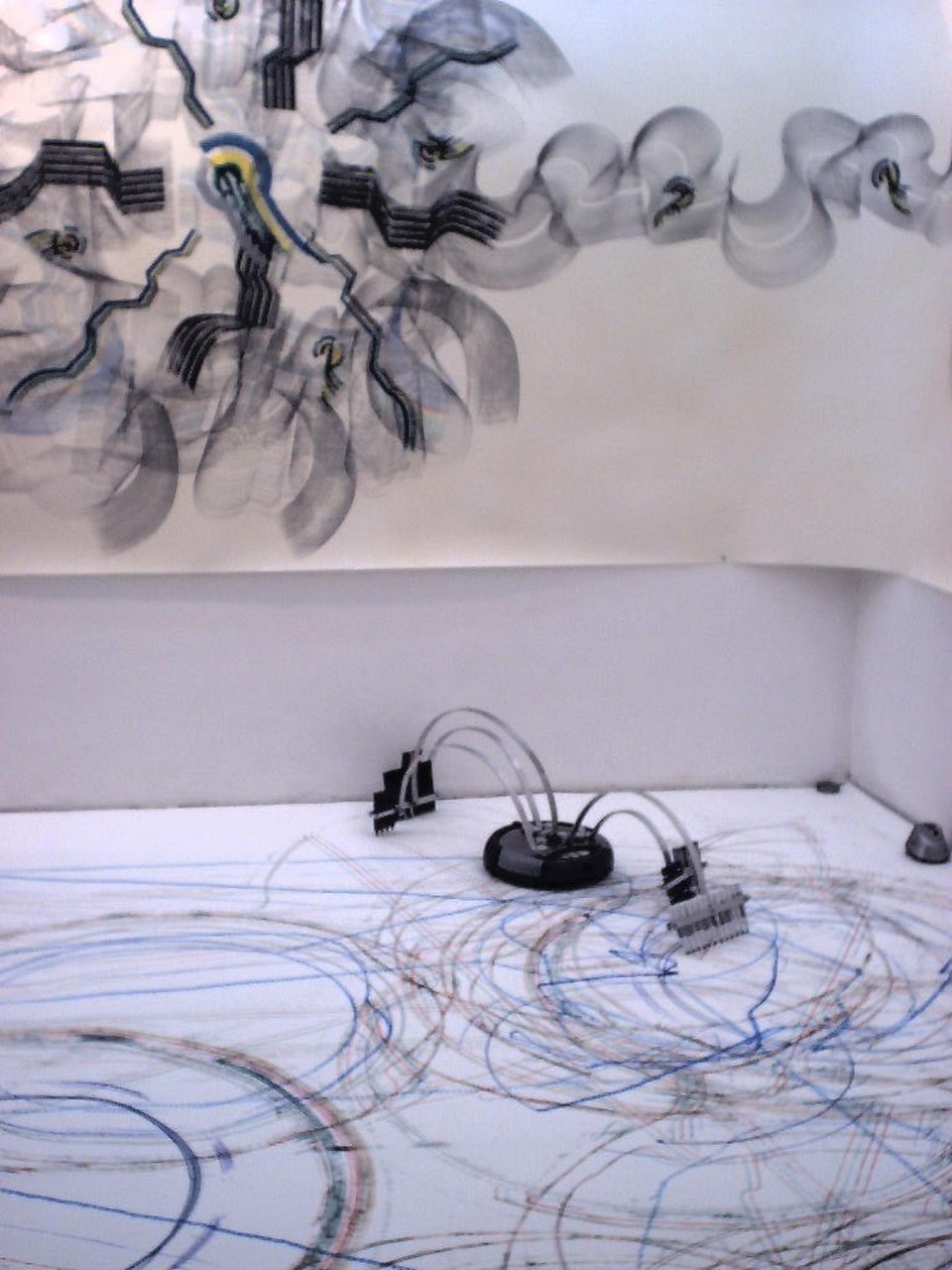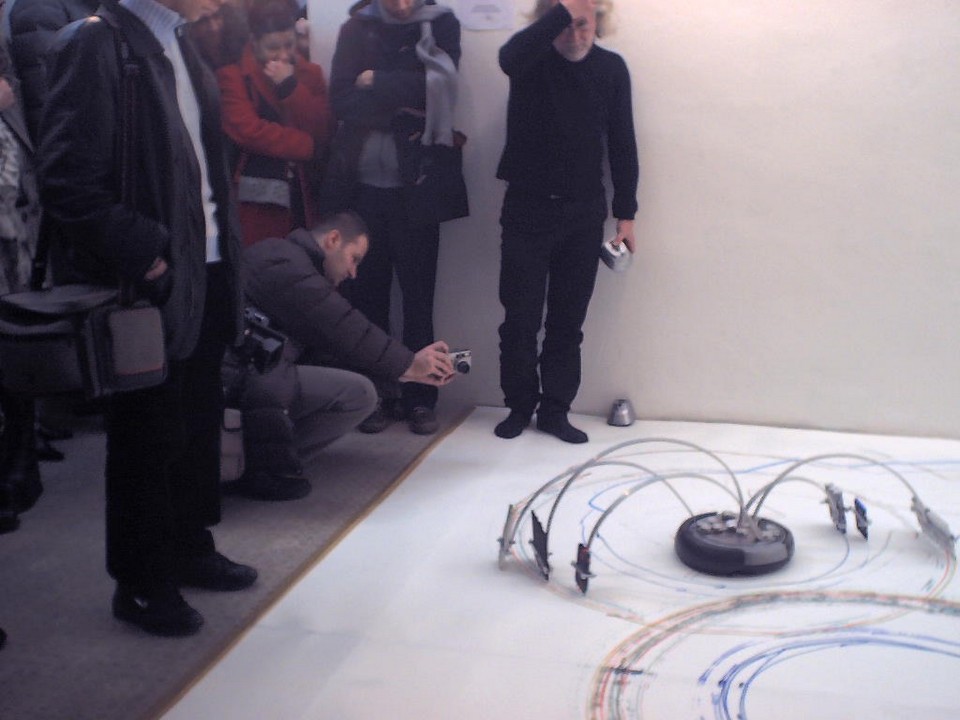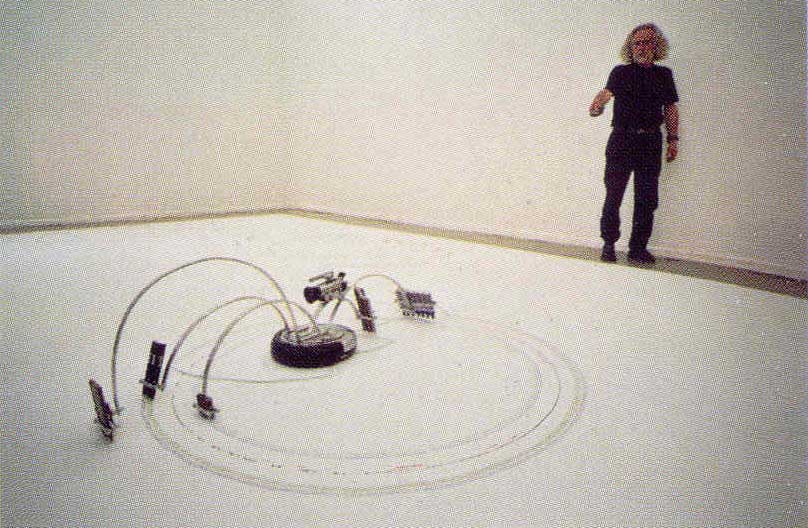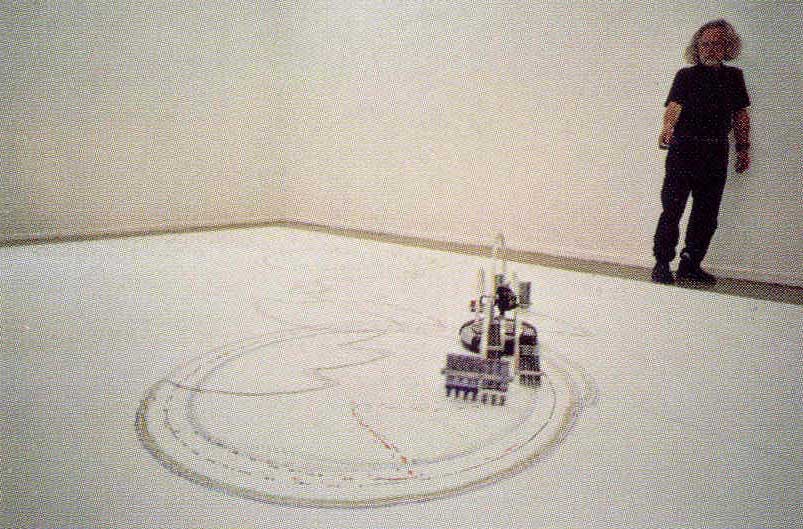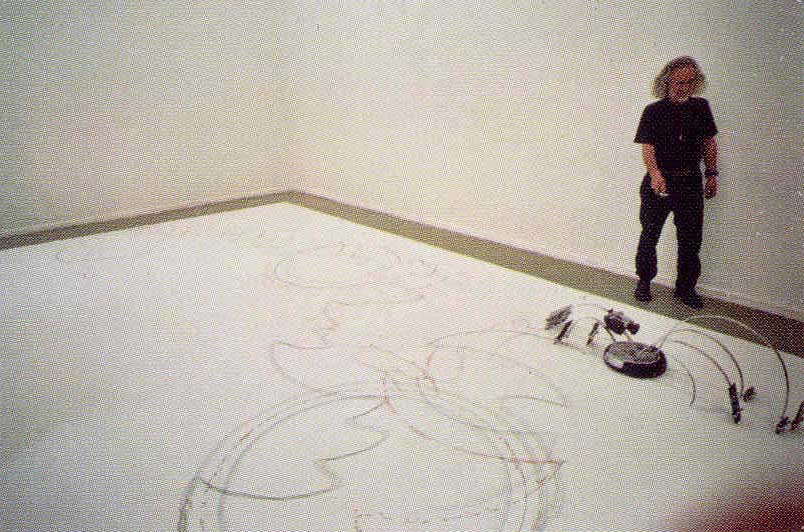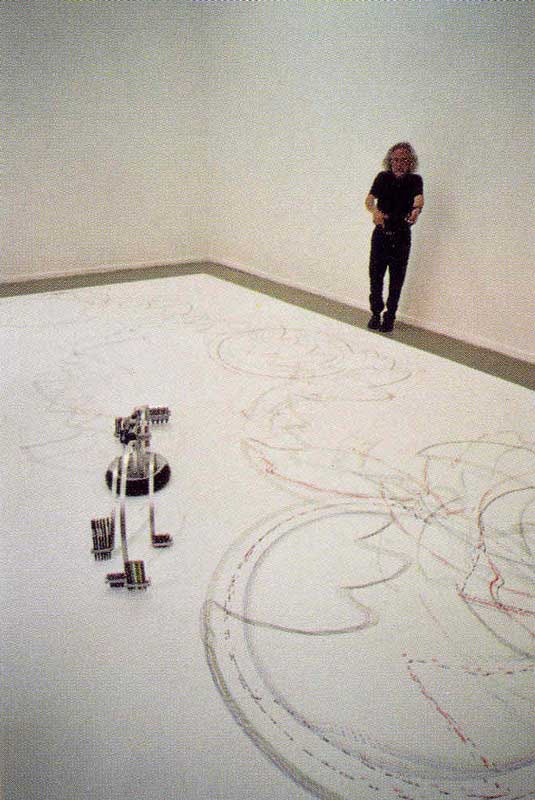RoboAction 1
Performance and Installation
Curator: Andrej Tisma
Location: Cultural Center, Novi Sad, 2004
RoboAction 2
Interactive Drawing Installation
Duration: 1 hour
Location: Gallery of SKC, Belgrade
Dragan Illc deals with the conceptual analysis of the process of drawing as an expressive form in visual arts, and with technologies of inscribing bodily actions onto the surface of the paper. His works thematize the process of the creation of a drawing, materials used in that process and the technological devices that mediate in it. Whatever is being used or activated in the process of producing a drawing is being introduced this way into the realm of the art: pens, brushes, tubes and pencils, different prosthetic devices that intercede their utilization, as well as the system of transfer utensils which move them within the frame of an interactive, technologically mediated performance, which enables the visitors to produce the drawing themselves by the use of remote controlled home robots.
Works of Dragan Ilic investigate the relation between technology and imagination, autonomy of artistic expression and the automatism of mechanical action, as well as the relation between the diagram and the drawing, in the process of work that involves the use of artificial intelligence in the course of a drawing action. Automatized devices that produce the work exhibited in the show were introduced into the drawing practice in order to brake the routine of the draftsman and the skill of performing a graphic figure, forcing thereby the author to get to the same level as any visitor in respect of the competences for the act of drawing. The hand of the draftsman, mechanical and electronic devices that usually serve as its extensions, pens, brushes, pencils and tubes attached to them in order to bring about the performing of the act in the creative sense, are being here brought down to their basic materiality, and introduced in a privileged way into the spatial settings and actions, as their only content, or the instantiation of the topic of the exhibition in a straight and direct manner.
The artist is in this context is represented as the panic subject of the technologically framed civilization, in which the difference between the mechanical prosthesis and its organic bearer, between the individual body of the artist and the collective, media interceded / produced collective body of the collective to which he belongs, between the act of creation and its simple mechanical reproduction, as well as between the products and byproducts of art is being gravely diminished through various hybrid forms. Authorship in this performance is shared between а11 participants in the event – the artist, who is the carrier of the action in fact produces the context in which the drawing is being shaped through the interaction between the temporary users of refurbished robots and the minimal setting of the gallery space, where the whole floor is in fact а sheet of paper that keeps bearing the traces of whatever is being physically introduced into the setting, including the audience and the robots.
One can encounter here also а total de-sublimation of myths on draftsman’s skills, on the hand of the master, and on the transgressiveness of entering the space of the image, or any other visual representation. Immediate, physical entering into the space of the drawing, and leaving traces of one’s own rhythms on it, does not hold as а sole privilege of an artist, but а necessity of being present in the event, and taking over the mandate for active participation in producing а visual representation and it’s inauguration into а drawing of а new kind.
What strikes the viewer in this work is also the missing place of the author, which is not being emptied in the sense of it being reduced only to an ‘author function’, which is the simple connecting element between different acts and products as belonging to the same body of work, but in the sense of non-existent materialization of authorship within one physical individual – whoever makes some lines by the use of remote controlled robot in this work acts as the author. The subject is also not cancelled by an intelligence superior to human, the robot in case is not а high-tech robot with it’s own will and performative capacities unknown to human bodies, but а simple refurbished used home machine, which is capable of drawing lines by moving over the paper, directed by human action initiated and controlled by whomever may recognize oneself as actor in the whole event.
What we have here is а post-subjective art, if we define the subject as unique autonomous creative force that willingly operates through the acts of an individual, and if we read the prefix ‘post’ as the signifier of а kind of unnamed multitude, which comes to act when the authority of individual as creator is being removed and the field of action is being let over to whomever would take part into the opening, or visit the show. The work, also, does not focus on the product of the action, but on its productive matrix, and on the very structure of relations in the process of production, presentation and reception of the drawing act, where they are totally de-hierarchized, and mutually interlaced.
Iп an indirect manner, the basic traumatic point of science fiction is also thematized here: and it is that the high organic civilizations produce self-replicating, self¬programming machines who will supersede then, after eliminating any need for the organic part of the civilization that made them. The allegorical point to introducing this topic is usually the analysis of the status of human beings in highly technologized societies, in which every experience and every expression is being mediated by multiple technological instances which are, because of the complexity of their structures, rendered to be completely out of any perceptive capacities of an electronically un-enhanced individual, being at the same time the basic of his everyday functioning. Human individual is here completely replaceable and redundant in the productive sense, relevant only in the experiential one.
Traditionally, in our western civilization, the human subject is being understood as а unique, as controlling, and as transcendent to the pure physical world. Today, in the times when the subject is simulated, morphed, genetically fabricated, supplied with artificial memories, artificial experiences and prosthetically enhanced, his body, and the soul that is consider to act through it, are showing to be incomplete and inadequate to the process of creation. The limitations of human bodies, as restricted to а bounded set of movements and actions, made ground for the dream on а certain kind of а digital chip whose insertion would enable one to control the activities of а machine by mental activities only – that is the dream on the omnipotence of thoughts, technologically colored and introduced into the domain of scientific technological achievements, independent from any psychology and any type of individuality. Transferred into the register of artistic practice, it would mean that the skills of manual implementation of ideas, however perfected they may be, are always insufficient of producing something fully adequate to them, and that the dream on а medium that would directly convey ideas has its significant role as regulative in respect of аll those practices of high similarity level in expression, which are made into the normative ones in the area of visualizing thoughts through some kind of an image.
If man is, as Thomas Carlyle has stated, а tool-making and tool-using animal, then this animal is completely dependent on the performances of the tools onto which it relies in its actions. Those performances can be exploited in а purely goal-related rational manner, as а condition of possibility for achieving some material effect and gathering some profit, but they сап also be used as mediators of creative acts. Until we get enhanced through digital chip insertion, we will have to be enslaved by limitations of tools and utensils which we use, in both senses, and the only thing left to those who insist on creativity is to use that fact of limitation on а way that upgrades the quality of the final product, which is that it contextualizes the actual state of affairs.
Stevan Vukovic




